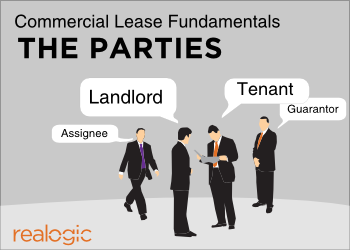 Following up on last week’s blog article, The Four Components of a Real Estate Lease, today’s post explains the first part of what Realogic considers the first component, the basic lease information. Let’s consider the parties involved in a commercial real estate lease.
Following up on last week’s blog article, The Four Components of a Real Estate Lease, today’s post explains the first part of what Realogic considers the first component, the basic lease information. Let’s consider the parties involved in a commercial real estate lease.
Required Parties
Identifying the parties in a commercial lease may seem like an “easy” task. It can get more complicated, however, as additional lease documents such as assignments, subleases, mergers, consolidations and name changing amendments occur in the months and years after lease execution. Since any one of these (possibly one-page) documents completely shifts the burden to perform lease obligations, it is crucial to identify who plays what role throughout the life of a lease.
Lessor: Commonly known as the Landlord, the lessor in a lease is defined as the party offering the space for occupation by the Lessee in exchange for money.
Lessee: Also known as the Tenant, a lessee is the party responsible for occupying the offered space and payment of Base Rent and Additional Rent under the terms described in the lease. One note to keep in mind when identifying the lessee is that very often the legal name will be very different from the “Doing Business As” or DBA name. It is important to document both names when reading a commercial real estate lease in any lease abstract or lease administration capacity.
Optional Parties
Guarantor: A guarantor is a person or entity that agrees to perform the contractual obligations of another if the other party fails to perform them. Guarantors can either be person or corporate and essentially function as a way for the lessor to limit the risk of a default by a Lessee.
Assignor / Assignee: The party making the transfer of one’s property, interest or rights in a lease to another party (the Assignee). In a lease assignment, the Assignor transfers some or all of their rights to use leased property to the Assignee for the unexpired remainder of the lease term. In most assignments, the Assignee acquires the same rights and privileges, and assumes the same obligations, which belonged to the Assignor. In addition, the Assignor typically remains liable for any lease obligations which are not fulfilled by the Assignee after the lease has been assigned, unless relieved of such obligations by the landlord. Assignments usually require landlord’s consent.
Sublessor / Sublessee: When a tenant makes the decision to vacate the premises but does not wish (or is not granted permission) to end the lease, they may make arrangements for another party to occupy the leased space. The document of record controlling the rights and obligations of each party in this scenario is called a sublease and the parties to that agreement are called sublessor (or sublandlord) and sublessee (or subtenant). It is important to note that subleases under most circumstances do not release the sublandlord (who is also the lessee/tenant under the original lease) from its duties and obligations set forth in that original lease.
Other Parties that can affect Commercial Real Estate Leases
Anchor Tenant: In retail commercial real estate, an anchor tenant is the primary tenant in a shopping center. Larger shopping centers may have more than one anchor tenant. Rent for an anchor tenant is often significantly lower than for other tenants in a shopping center because they are the tenants who draw consumers to the center. Due to this unique quality, retail real estate leases occasionally have clauses that reduce rents for a tenant or even trigger the activation of a termination option via a co-tenancy clause if an anchor tenant leaves the shopping center.
Are there other parties that can affect a lease? Of course, but I believe this list is a good roundup of the people and businesses that normally are involved in commercial real estate leases. If you think other parties deserve specific mention or an explanation, please add them in the comments below this post.